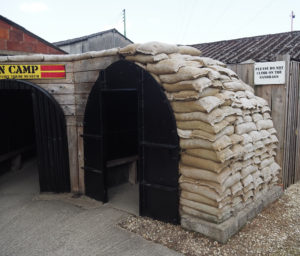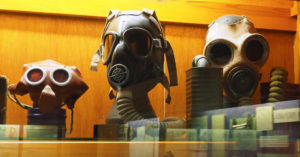This is a fascinating place to visit.
On the outskirts of Malton, this was originally one of about 1500 Prisoner of War Camp built to accommodate Italian and German POWs between October 1939 and July 1948. The first prisoners were 250 Italians who arrived in Malton by train and were marched to the site. They were initially housed in bell tents and helped to build a more permanent camp which was occupied by Italian and later German prisoners. The completed camp covered 8 acres and had 45 huts. 18 of the huts were barrack huts housing 64 prisoners in each. Other huts included hospital, laundry, ablutions, mess hut, shop and theatre. There were also huts for the admin and guard’s quarters. The Regimental Police were responsible for the security of the camp and prisoners and also provided escorts along with the guards for POWs who were contracted to work for local farmers.
The camp was surrounded by barbed wire fencing strung between wooden posts, with an overhang at the top. There were wooden guard towers at intervals. There was a smaller barb wire fence inside the perimeter which was a ’no go’ area.
After the war, it became a War Agricultural Holiday Camp for students and people from across the UK and Europe, who used if for working holidays. It was later used as a warehouse for a local seed merchant before being left derelict.
The camp reopened in 1987 as the world’s first Modern History Theme museum.
The 29 huts and three mess tents give visitors the chance to experience the sights, sounds and smells of life at home and at war. The huts have been restored and now house a series of displays illustrating different aspects of WW2, beginning with the rise of the Nazi party to VJ day.
There are information panels, posters, artefacts, appropriate sounds and smells as well as reconstructions of scenes showing what life was like. Visitors can experience the cramped conditions of life in a German U boat, admire the bravery and courage of British prisoners digging tunnels to escape from camps in Germany, and see just how meagre the food ration was. One hut is set up as it would have been when the prisoners of war were based here. Another hut has been set up with a display about WW1 and others cover later conflicts including the Korean War, Suez, the Falklands and Kosova. There is also a 1946 prefab complete with fitted kitchen and bathroom which must have felt like real luxury to the families living in it.
There are military vehicles around the site, as well as examples of air raid shelters and a doodle bug.
There really is something for everyone, including a children’s play area. Allow plenty of time for a visit. There is a lot to take in. This is a place that deserves many visits – a ‘preliminary’ visit to get a general over view, followed by further visits to concentrate on the huts that really interest you. To read and take in all the information in a hut could easily take a couple of hours.
“Website”:https://www.edencamp.co.uk/









